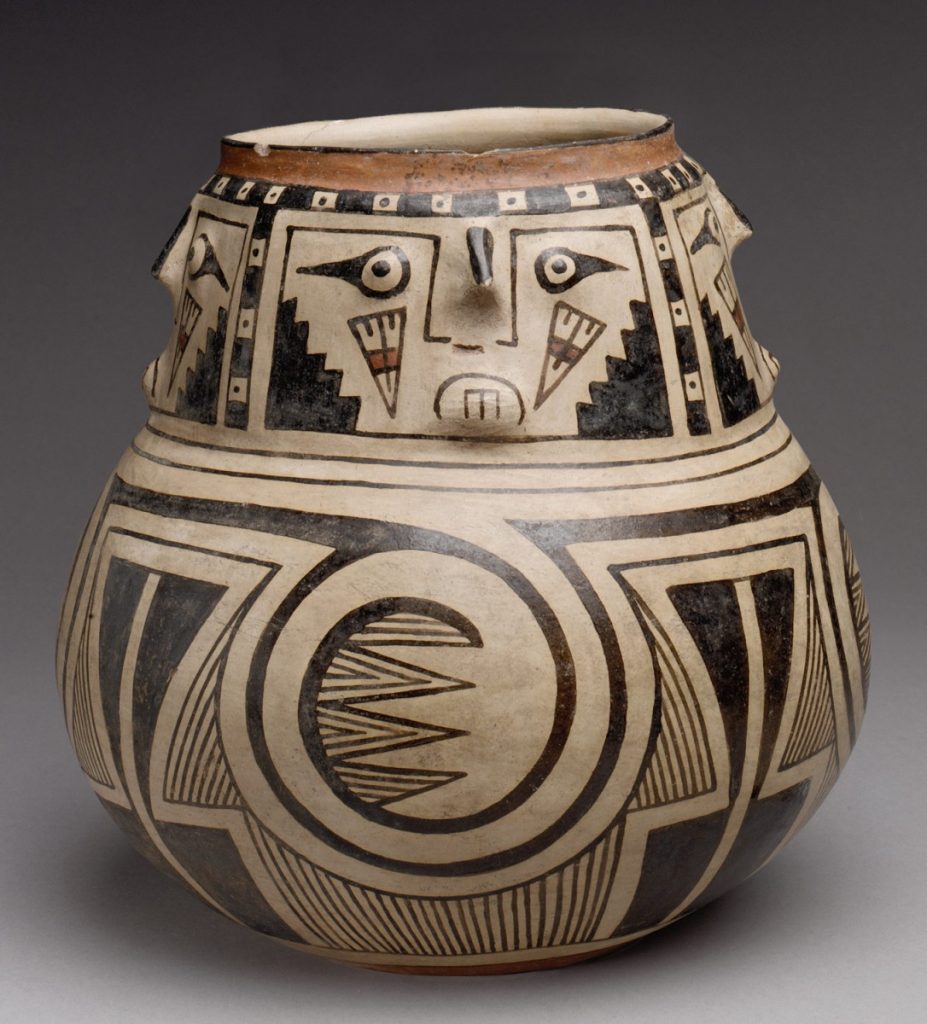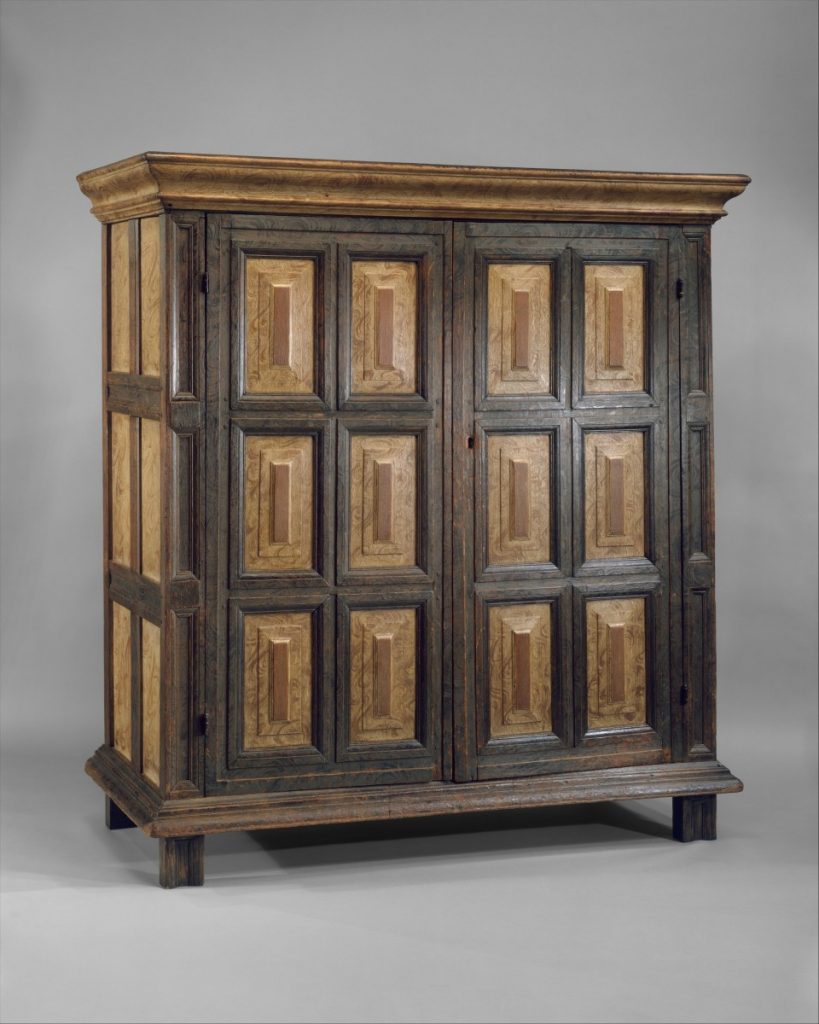Table of Contents
LESSON 1: The Southwest and “New Spain.”
WHAT TO READ, WATCH, OR LISTEN TO BEFORE CLASS.
From your textbook, American Encounters:
- Read introduction to Part 1: “From Ancient Times to the Late Colonial Era,” page 1.
- Chapter 1, “The Art of Indigenous Americans,” map of Ancient America, page 4. Focus on Casas Grandes, Anasazi, and Mimbres.
Table 1.1, page 6. “Time Periods in Ancient America.” Focus on SOUTHWEST. - Read “Ancient Art of the Southwest,” pages 17-21. Focus on the Anasazi or Ancestral Pueblo culture and their neighbors, the Mimbres.

From the Metropolitan Museum of Art:
Read about the Jar with Four Faces, from the Casas Grandes culture, made between 1250 and 1450 (approx.)
From the Seeing America project at Smarthistory:
Video (5 min.): New Spain. Related map and text, “Northern New Spain: Crossroads of Cultures,” pages 43-44 in American Encounters.
Video (5 min.): An “imported” Baroque. Related church under “Arizona Missions”, pages 110-112, in American Encounters. Images of the facade, p. 94, and the retablo (altar screen), p. 112.
WHAT TO SEE, SKIM, OR SAMPLE AS TIME ALLOWS.
Local and contemporary portals to the past:
Video (4 min.): The Virgin of Guadalupe. Related text, “The Virgin of Guadalupe: Transnational Icon,” in the section on Hispanic Village Arts, p. 75, American Encounters.
NYC museum site: National Museum of the American Indian in lower Manhattan near Battery Park.
- For Southwest indigenous art like this week’s objects, select Southwest from the exhibition site Infinity of Nations. Scroll down for text, images, and a map. We will see this in class.
- For living artists, select Contemporary Art or see the group show Ancestral Traditions.
LESSON 2 – Colonies on the East Coast.
WHAT TO READ, WATCH, OR LISTEN TO BEFORE CLASS.
From your textbook, American Encounters:
Chapter 3, “Early Colonial Arts: 1632-1734,” pages 56-93.
- Browse the city plans and maps from page 59 to 67. Which American cities developed organically? Which were based on a grid? Why do you think there is no example of the radial plan?
- Read “The Puritan Ideal” on page 64 and compare it to the analysis of the Freake family portraits, pages 67 to 70.
- Why are the two churches on pages 78 and 79 so different?
- Browse through the four east coast houses pictured in this chapter. In class, we will compare a simple farmer’s house to the relatively grand brick “castle” built in Virginia in 1655.
A radio program from the British Museum:
Listen: (15 min.) The Akan Drum from the History of the World in 100 Objects, from the British Museum. (If the player doesn’t work for you, download the mp3 file.) Compare the radio program to the interpretation of the drum in your textbook, pages 90-91. Why might they be different?

From the Metropolitan Museum of Art:
- A kast is a Dutch type of cabinet; this one was probably made in NY or New Jersey in the seventeenth century.
- Compare a joined arm chair, like the one on page 84 in your book, to an early turned chair, both from Massachusetts. Arm chairs were special. Who would have sat there?
WHAT TO SEE, SKIM, OR SAMPLE AS TIME ALLOWS.
A portal from the twentieth century to the colonial past:
George Washington was born in rural Virginia in 1732, in a house built by his family at about the same time as the objects in this lesson. Ideas about his character, as well as that of the Puritans, are part of the stories that Americans still tell themselves about their country and themselves.
Video: (6 min.): Grant Wood painted the myth of Washington and the cherry tree in 1939. It’s hard to tell exactly what he meant by it. Sarcasm? Patriotism? In 1930, right after the financial crash of 1929, he painted American Gothic (Video: 6 min.) Your textbook (pages 491 to 493) reads the farmer in the second painting as having a typically American “puritanical” streak, supposedly inherited from the Freake family and their friends. Both paintings contain some humor. Do you think it is mocking or sympathetic?
LESSON 3: Art and Property in the Eighteenth Century.
WHAT TO READ, WATCH, OR LISTEN TO BEFORE CLASS.
From your textbook, American Encounters:
- In Chapter 3, read “Conclusion,” page 93, and Chapter 4, opening three paragraphs, page 95.
- In Chapter 4, read “The African Diaspora,” pages 95 to 98. Focus on Plantation Scene, page 96.
- Read “The Classical Orders,” page 101, and “Palladio and Georgian Building,” pages 102 to 105. Focus on Mount Airy in Virginia and Mount Pleasant in Philadelphia.
- Browse “The Crafted Object,” pages 114 to 118. Focus on Benjamin Franklin and his wife’s purchase of “a China bowl with a spoon of Silver.”
- Browse “Artists Painting,” pages 120 to 131. Focus on Smibert’s Bermuda Group, Copley’s Paul Revere, and the three history paintings by Benjamin West.
From the Metropolitan Museum of Art:
Essay and slide show: “Art and Identity in the British North American Colonies, 1700-1776.”

From Yale University Art Gallery:
John Smibert, Dean Berkeley and his Entourage (The Bermuda Group), 1729. Public Domain. See also page 120 in American Encounters and an in-depth essay from Seeing America for a very deep dive. The man at the far right, George Berkeley, authored a famous phrase that became part of American history: “Westward the Course of Empire Makes its Way.”
From the Seeing America project by Smarthistory:
Video (4 min.): Boy with a Squirrel by John Singleton Copley, 1765. The artist was 28.
Video (5 min.): The story of trade and wealth in a silver sugar bowl, 1745. Watch for the appearance of John Greenwood’s painting from page 129.
WHAT TO SEE, SKIM, OR SAMPLE BEFORE CLASS AS TIME ALLOWS.
Photographs and a new discovery — portals to the past:
The Old Plantation, a watercolor now attributed to John Rose of Beaufort, South Carolina, appears on page 96 in your textbook as “Plantation Scene, unknown artist”. The Abby Aldrich Rockefeller Folk Art Museum published new information about the painting in 2010. An important clue was a related watercolor of an African-American woman, Miss Breme Jones, by John Rose, with a poetic inscription from Milton’s Paradise Lost. The researcher was able to tentatively identify the people in the painting. (Based on new research by Susan P. Shames, Colonial Williamsburg Foundation.)
Along with the images in Chapter 3 of your textbook, photographs from a Campbell County, Virginia, slave-holding plantation show what the environment of the people in the watercolor might have been like.
LESSON 4: Enlightenment Ideals.
WHAT TO READ, WATCH, OR LISTEN TO BEFORE CLASS.
From your textbook, American Encounters.
- Read the introduction to Part 2: “Forging a New Nation, 1776 to 1865,” page 133. Focus on the Enlightenment, American “types”, and the idealization of the countryside.
- Chapter 5: Read the opening three paragraphs, page 135. Focus on Neoclassicism.
- Browse “Print Wars” and compare the wounded and dying figures in the images, pages 137 to 141.
- Browse the portraits from page 141 to 145. We will talk about how revolutionary leaders became icons at home and Enlightenment heroes in France.
- Read “The African American Enlightenment,” pages 145 to 148. Focus on Joshua Johnson (or Johnston).
- Browse “Classical America,” pages 149 to 163. Focus on Jefferson in Virginia, Bulfinch in Boston, and Latrobe in DC.
- Browse “Painting in the New Nation,” pages 163 to 169. Focus on the Peale family.

From the National Gallery of Art in Washington, DC:
Rubens Peale with a Geranium, 1801, by his brother Rembrandt Peale. How do the Peales demonstrate their Enlightenment values?
From the Metropolitan Museum of Art:
Browse this image gallery of eighteenth century needlework. How did women’s education differ from men’s?
From the Seeing America project at Smarthistory:
- Video (4 min.): Charles Willson Peale, The Staircase Group, 1795. See also page 132 and 164 in your textbook.
- Video (5 min.): Charles Willson Peale, Yarrow Mamout, 1819. An African Muslim among the Enlightenment icons.
- An in-depth look at Charles Willson Peale’s The Artist in his Museum, 1822. (Page 165 in your textbook.)
WHAT TO SEE, SKIM, OR SAMPLE AS TIME ALLOWS.
Contemporary portals to the Enlightenment past:
- Video (4 min.) from Seeing America: Nari Ward, We the People, 2015. A contemporary artist recreates the opening words of the Constitution (inspired by Enlightenment ideas).
- The Instagram site of the Biodiversity Heritage Library (an open access research database). Botanical drawings from the Enlightenment era; the Peale family and J. J. Audubon worked in this tradition.
And to end the lesson, an eighteenth-century vision of nature from the Met.

Print this page



